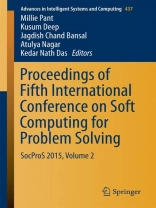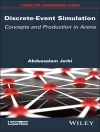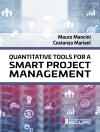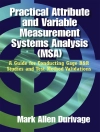The proceedings of Soc Pro S 2015 will serve as an academic bonanza for scientists and researchers working in the field of Soft Computing. This book contains theoretical as well as practical aspects using fuzzy logic, neural networks, evolutionary algorithms, swarm intelligence algorithms, etc., with many applications under the umbrella of ‘Soft Computing’. The book will be beneficial for young as well as experienced researchers dealing across complex and intricate real world problems for which finding a solution by traditional methods is a difficult task.
The different application areas covered in the proceedings are: Image Processing, Cryptanalysis, Industrial Optimization, Supply Chain Management, Newly Proposed Nature Inspired Algorithms, Signal Processing, Problems related to Medical and Health Care, Networking Optimization Problems, etc.
Mục lục
Chapter 1. Traffic Accident Prediction Model Using Support Vector Machines with Gaussian Kernel.- Chapter 2. A Brief Overview on Least Square Spectral Analysis and Power Spectrum.- Chapter 3. ASCCS: Architecture for Secure Communication Using Cloud Services.- Chapter 4. Multi-Objective Optimization Based Design of Robust Fractional Order PIλDμ Controller for Coupled Tank Systems.- Chapter 5. Using Least Square Spectral Analysis Method for Time Series with Datum Shifts.- Chapter 6. Application of Differential Evolution for Maximizing the Load Ability Limit of Transmission System During Contingency.- Chapter 7. Common Fixed Point Theorem for Occasionally Weakly Compatible Mappings in Fuzzy Metric Spaces.- Chapter 8. Privacy Preservation in Utility Mining Based on Genetic Algorithm: A New Approach.- Chapter 9. Reliability Evaluation of Software System Using AHP & Fuzzy TOPSIS Approach.- Chapter 10. Information Security and Its Insurance in the World of High Rise of Cybercrime through a Model.- Chapter 11. A Systematic Study on Mitigating Parameter Variation in MOSFETs.- Chapter 12. Vendor – Supplier Cooperative Inventory Model with two Warehouse and Variable Demand Rate under the Environment of Volume Agility.- Chapter 13. Invariant Feature Extraction for Finger Vein Matching Using Fuzzy Logic Inference.- Chapter 14. Fuzzy Reasoning Approach (FRA) for Assessment of Workers Safety in Manganese Mines.- Chapter 15. Multiple-input Multiple-output Paper Machine System Control Using Fuzzy-PID Tuned Controller.- Chapter 16. Common Fixed Point Results in GB Metric Space and Generalized Fuzzy Metric Space using E.A. Property and Altering Distance Function.- Chapter 17. Design Optimization of Sewer System Using Particle Swarm Optimization.- Chapter 18. Optimal Tuning of PID Controller for Centrifugal Temperature Control Systemin Sugar Industry Using Genetic Algorithm.- Chapter 19. Fault Diagnosis of ZSI Fed 3-phase Induction Motor Drive System Using MATLAB.- Chapter 20. Open MP Genetic Algorithm for Continuous Non-linear Large Scale Optimization Problems.- Chapter 21. Combined SCP and Geometric Reconstruction of Spine from Bi-planar Radiographs.- Chapter 22. Analysis of Network IO Performance in Hadoop Cluster Environments Based on Docker Containers.- Chapter 23. Hough Transform Based Feature Extraction for the Classification of Mammogram Using Back Propagation Neural Network.- Chapter 24. Ant Colony System Based E-supermarket Website Link Structure Optimization.- Chapter 25. An Aggregation Based Approach with Pareto Ranking in Multi-objective Genetic Algorithm.- Chapter 26. Weighted Co HOG (W-Co HOG) Feature Extraction for Human Detection.- Chapter 27. Municipal Solid Waste Generation Forecasting for Faridabad City located in Haryana State, India.- Chapter 28. Secondary Network Throughput Analysis Applying SFR in OFDMA-CR Networks.- Chapter 29. Unsupervised Change Detection in Remote Sensing Images Using CDI and GIFP-FCM Clustering.- Chapter 30. Performance Comparison between In P-ON and SON MOSFET at Different Nanotechnology Nodes Using 2-D Numerical Device Simulation.- Chapter 31. Discrete-time Eco-epidemiological Model with Disease in Prey and Holling-Type III Functional Response.- Chapter 32. A Novel Crossover Operator Designed to Exploit Synergies of Two Crossover Operators for Real Coded Genetic Algorithms.- Chapter 33. Classification Techniques for Texture Images Using Neuroph Studio.- Chapter 34. Optimization of Feature Selection in Face Recognition System Using Differential Evolution and Genetic Algorithm.- Chapter 35. Human Opinion Dynamics for Software Cost Estimation.- Chapter 36. A Comparative Study of Various Meta-heuristic Algorithms for Ab Initio Protein Structure Prediction on 2d Hydrophobic-Polar Model.- Chapter 37. Population Segmentation Based Variant of Differential Evolution Algorithm.- Chapter 38. PSO Optimized and Secured Watermarking Scheme Based on RDWT and SVD.- Chapter 39. Spectral Indices Based Change Detection in an Urban Area Using Landsat Data.- Chapter 40. An Approach to Protect Electronic Health Records.- Chapter 41. Analysis and Design of Secure Web Services.- Chapter 42. A Fuzzy Clustering Method for Performance Evaluation for Distributed Real Time Systems.- Chapter 43. Image Segmentation Using Genetic Algorithm and OTSU.- Chapter 44. On Accepting Hexagonal Array Splicing System with Respect to Directions.- Chapter 45. Tracking Movements of Human Being in a Real-Time Surveillance Scene.- Chapter 46. An Inventory Model of Decaying Items with Stock Dependent and Seasonal Pattern Demand and Allowable Shortages.- Chapter 47. Using Differential Evolution to Develop a Carbon Integrated Model for Performance Evaluation and Selection of Sustainable Suppliers in Indian Automobile Supply Chain.- Chapter 48. A New Approach for Rice Quality Analysis and Classification Using Thresholding Based Classifier.- Chapter 49. Differential Power Attack on Trivium Implemented on FPGA.- Chapter 50. Investigations of Power and EM Attacks on AES Implemented in FPGA.- Chapter 51. Application for Identifying and Monitoring Defaulters in Telecom Network.- Chapter 52. An Efficient Approach for Mining Sequential Pattern.- Chapter 53. A Better Approach for Multilevel Association Rule Mining.- Chapter 54. Prediction of Market Power Using SVM as Regressor under Deregulated Electricity Market.- Chapter 55. Design of Boost Converter for PV Applications.- Chapter 56. A Review of Soft Classification Approaches on Satellite Image and Accuracy Assessment.- Chapter 57. A New Collaborative Approach to Particle Swarm Optimization for Global Optimization.- Chapter 58. Reliability Optimization for the Complex Bridge System: Fuzzy Multi-criteria Genetic Algorithm.- Chapter 59. Laser Power Distribution for Detection Performance in Laser Ranging System.- Chapter 60. Numerical solution of a Class of Singular Boundary Value Problems Arising in Physiology Based on Neural Networks.- Chapter 61. Prototype Evidence for Estimation of Release Time for Open Source Software Using Shannon Entropy Measure.- Chapter 62. A Broad Literature Survey of Development and Application of Artificial Neural networks in Rainfall-Runoff Modelling.- Chapter 63. Development of i MACOQR Metrics Framework for Quantification of Software Security.- Chapter 64. Miniaturized Meandered and Stacked MSA Using Accelerated Design Strategy for Biomedical Applications.- Chapter 65. Artificial Bee Colony Trained Functional Link Artificial Neural Network Model for Software Cost Estimation.- Chapter 66. Improvised Cyber Crime Investigation Model.- Chapter 67. Performance of Wideband Falcate Implantable Patch Antenna for Biomedical Telemetry.- Chapter 68. Mining Frequent Itemset Using Quine-Mc Cluskey Algorithm.- Chapter 69. Robotics and Image Processing for Plucking of Fruits.- Chapter 70. A Review on Role of Fuzzy Logic in Psychology.- Chapter 71. Modified Single Array Selection Operation for DE Algorithm.- Chapter 72. Optimal Extraction of Bioactive Compounds from Ashwgandha Using Laplacian Biogeography Based Optimization.- Chapter 73. Implementation of ‘Fmincon’ Statistical Tool in Optimizing the SHG Efficiency of Polymeric Films.- Chapter 74. Curve Fitting Using Gravitational Search Algorithm and Its Hybridized Variants.- Chapter 75. Investigation of Suitable Perturbation Rate scheme for Spider Monkey Optimization Algorithm.- Chapter 76. A Portfolio Analysis of Ten National Banks through Differential Evolution.- Chapter 77. Applications of Harmony Search Algorithm in Data Mining: A Survey.- Chapter 78. Enriched Biogeography Based Optimization Algorithm to Solve Economic Power Dispatch Problem.- Chapter 79. Modified Artificial Bee Colony Algorithm Based on Disruption Operator.- Chapter 80. DG Integration with Power Quality Improvement Feature for Smart Grid.- Chapter 81. Asynchronous Differential Evolution with Convex Mutation.- Chapter 82. Equilibrium Cable Configuration Estimation for Aerostat Using Approximation Method.- Chapter 83. Differential Evolution Approach to Determine the Promotion Duration for Durable Technology Product under the Effect of Mass and Segment Driven Strategies.- Chapter 84. A Fuzzy Optimization Approach for Designing a Sustainable RL Network in a Strategic Alliance between OEM and 3PRL.- Chapter 85. Fuzzy Bi-Criteria Optimization Model for Fault-tolerant Distributed Embedded Systems under Reuse-or-Build-or-Buy Strategy Incorporating Recovery Block Scheme.- Chapter 86. Hybrid Multi–criteria Decision Making Approach for Supplier Evaluation in Fuzzy Environment.- Chapter 87. Mathematical Modeling of Multistage Evaporator System in Kraft Recovery Process.
Giới thiệu về tác giả
Dr. Millie Pant is an Associate Professor with the Department of Paper Technology, Indian Institute of Technology Roorkee, Roorkee, India. She has to her credit several research papers in journals of national and international repute and is a well-known figure in the field of Swarm Intelligence and Evolutionary Algorithms.
Prof. Kusum Deep is working as a full time professor in the Department of Mathematics, Indian Institute of Technology Roorkee, Roorkee, India. Over the last 25 years, her research is increasingly well cited making her a central International figure in the area of Nature Inspired Optimization Techniques, Genetic Algorithms and Particle Swarm Optimization.
Dr. Jagdish Chand Bansal, is an Assistant Professor with the South Asian University, New Delhi, India. Holding an excellent academic record, he is an excellent researcher in the field of Swarm Intelligence at the National and International Level, having several research papers in journals of national and international repute.
Prof. Atulya Nagar holds the Foundation Chair as Professor of Mathematical Sciences and is the Dean of Faculty of Science, at Liverpool Hope University, Liverpool, UK. Prof. Nagar is an internationally recognised scholar working at the cutting edge of theoretical computer science, applied mathematical analysis, operations research, and systems engineering and his work is underpinned by strong complexity-theoretic foundations.
Dr. Kedar Nath Das is now working as Assistant Professor in the Department of Mathematics, National Institute of Technology Silchar, Assam, India. Over the last 10 years, he has a good contribution towards to research in ‘soft computing’. He has many papers to his credit in many journal in national and international level of repute. His area of interest is on Evolutionary and Bio-inspired algorithms for optimization.











